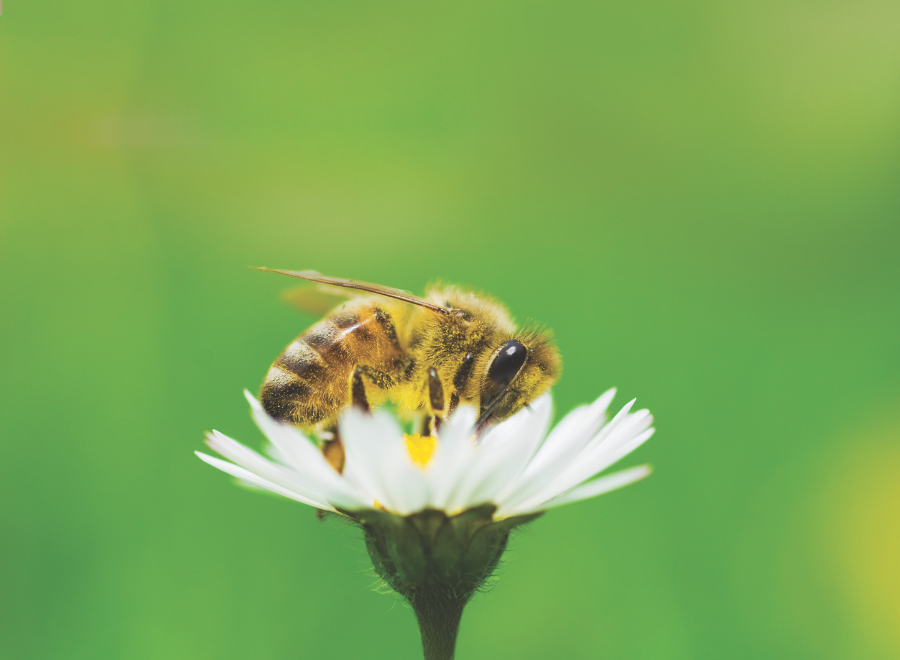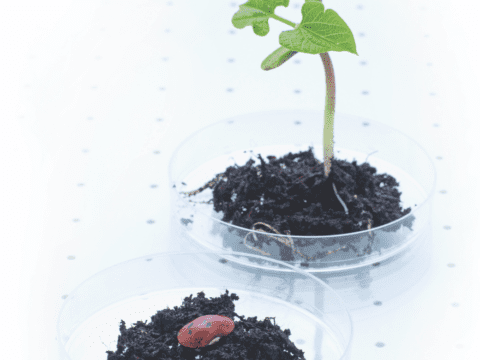On a sprawling research farm outside Guelph, Ont., Les Eccles smeared his face with queen bee pheromone beside an open hive. The honeybees swarmed to the bait, tickling his chin, holding tight with their tiny hooked feet, their long pink tongues licking off the scent. A perfect time for a photo — but the camera’s batteries were dead.
So Eccles hopped into a truck, still wearing the bee beard, and a buddy drove him back to the University of Guelph to take a picture. The vibrations from the car on the five-minute journey caused the bees to crawl all over his head, covering his eyes and his mouth. He couldn’t speak or see. But he didn’t get stung, and he did get a photo.
Eccles describes the event as a “rite of passage” for beekeepers. He was 27 at the time — a testament to his understanding of bee behaviour, his trust of the insects and his willingness to be vulnerable to the forces of nature. “A lot of people are scared of bees, but it was not scary at all,” he says on the phone from Milton, Ont., where he is the director of technology transfer for the Ontario Beekeepers’ Association (OBA). “When we work, we’re in T-shirts and shorts a lot of the time. Bees are gentle and social. . . . They’re willing to have you around.”
Eccles’s relationship with honeybees is based on a deep knowledge and a deep trust. But for most Canadians, Apis mellifera is panic-inducing, and not just because of its stinger. Five years ago this spring, beekeepers across North America cracked open their hives and found unusually high numbers of dead bees — or no bees at all, a phenomenon known as colony collapse disorder. Since then, many beekeepers have reported losses of between 30 and 80 percent of their colonies. Given that about one-third of the food we eat depends on honeybee pollination — in Canada, a $2-billion industry — bee disappearances are far scarier than the bees themselves.
Furthermore, the past decade’s rise in monoculture farms, combined with a decline in native pollinators like wasps, bumblebees, butterflies and beetles, means that honeybees are more needed than ever. Science has yet to offer a firm conclusion on the colony die-off. There’s no lack of hypotheses, though: pesticides, pesticides mixed with mitocides, viruses, Varroa mites (an Asian bug that nips gaping sores into bee flesh), air pollution (which disrupts bees’ ability to smell food) and severe winter weather caused by climate change. There are even theories about high-fructose corn syrup and cellphones. Most scientists believe the mystery of the missing honeybees is not a single, diagnosable what-dunnit but the result of a combination of forces.
For Eccles, the question isn’t so much what’s causing the decline as what to do about it. As part of his job, he researches the best practices to address bee problems and passes them on to Canada’s 7,000 apiarists. “Last year was one of the worst years in Ontario, with bee losses of up to 40 percent,” he says, noting that in Canada, colonies are not disappearing entirely as they are in the United States, but in-hive bee deaths are dramatically high. “When I first started doing this, the bees would take care of themselves. Now, beekeepers have to pay vigilant attention to pests, nutrition and other dangers. You see a lot of beekeepers getting out of the business.”
Despite the stress on bee populations, some hives are brimming with good health, Eccles says. He points to one of the OBA’s long-standing projects — an organic apiary. For organic-farming aficionados, healthy hives are not news. Sharon Labchuk, for example, has tended bees for more than 30 years at her “back to the land” farm near Charlottetown. Since 2007, she’s been scanning her online community of organic apiarists for news of uncontrolled mites, colony collapse and other troubles. None of the 3,000 organic beekeepers, she says, is reporting unusual rates of dead bees. In fact, she adds, half of Prince Edward Island’s commercially kept bees died in 2000. Yet her organic hives, which feed on her organic farm, were fine.
To Labchuk, this is political. As the province’s Green Party leader, she’s using the contrast between organic and conventional bee operations to rail against industrial farming practices that she believes are undermining bees and the security of our food supply. Commercial beekeeping mushroomed on the island following the introduction of massive blueberry farms. “If we hadn’t destroyed nature by destroying the wild and wild pollinators, we’d have lots of native bees around,” she says. “I’d like to eliminate monocultures and pesticides. If everyone just followed [smaller-scale] organic practices, the problem would be solved.”
Instead, commercial beekeepers have supersized their operations, according to a 2011 report by the Natural Sciences and Engineering Research Council of Canada. Since 1985, the number of bee colonies in Canada has remained unchanged, yet the number of beekeepers has dropped by two-thirds. This means more colonies per apiarist — and less time, ultimately, to devote to labour-intensive organic beekeeping methods.
Furthermore, Labchuk says, governments are not considering bees in their approval of certain chemicals. Back in 1995, she fought against Health Canada’s approval of a new set of insecticides called neonicotinoids. They’re known to be toxic to bees, she says; it says so on the label of every bottle. The fight failed. Now, researchers such as Dutch toxicologist Henk Tennekes, author of The Systemic Insecticides: A Disaster in the Making, are blaming bees’ new susceptibility to pests and disease on neonicotinoids.
But most politicians, industrial farmers and commercial beekeepers are not paying attention to the relationship between conventional agriculture practices and honeybees, Labchuk says. Instead, they’re just trying to fend off collapse.
Leading the charge against colony loss is Leonard Foster, a molecular biologist at the University of British Columbia. He grew up on a farm with bees and remembers extracting honey with his parents. Now, using data from honeybee gene mapping and diagnostic markers, Foster’s 20-researcher lab team is breeding a hearty “super bee” that’s resistant to disease and parasitic mites. The stronger bee stock will have more advanced grooming behaviour, a protection against hive infestation. Foster is hoping to have super bee queens ready for the market by 2014.
“If we can solve the problem in a couple of years, this will just be a blip in the history of beekeeping,” he says. “Should we panic? Well, that’s the $25,000 question. If [the decline] keeps going, we’ll depend more on imports and have to pay more for our fruits and vegetables. Farmers are already paying more for pollination services. But — contrary to so many hot media reports — we won’t be starving within the year.”
Foster agrees with Labchuk’s assertion that Canada should be supporting its native, wild pollinators. But he notes that without commercial honeybee pollination, farmers here couldn’t grow apples, canola, blueberries and other crops efficiently enough to make a living. And honeybees, which are not native to North America, can’t survive anywhere in Canada without human intervention, which includes keeping them warm and fending off pests. Foster’s breeding work, in other words, builds on a long history of honeybee domestication. He’s also quick to add that his research is only part of the solution. For example, Canada needs far more beekeepers, he says.
If the new vulnerability of honeybees is the result of several factors, correcting the problem seems equally nebulous. Money may be the answer to how this “blip” will ultimately be resolved. Labchuk points out that there’s plenty of corporate money available to fund studies to disprove the link between pesticides and bee decline, and to fund super bee labs such as Foster’s. There’s less money to promote organic beekeeping practices.
Ultimately, Eccles says, honeybees are naturally highly adaptable. With a six-week lifecycle, they build their numbers back up quickly after a loss. Still, it would be a mistake to place the brunt of solving this crisis on the shoulders of honeybees — super or not.
***
This story first appeared in The United Church Observer’s April 2012 issue with the title “The plight of the honeybee.”















